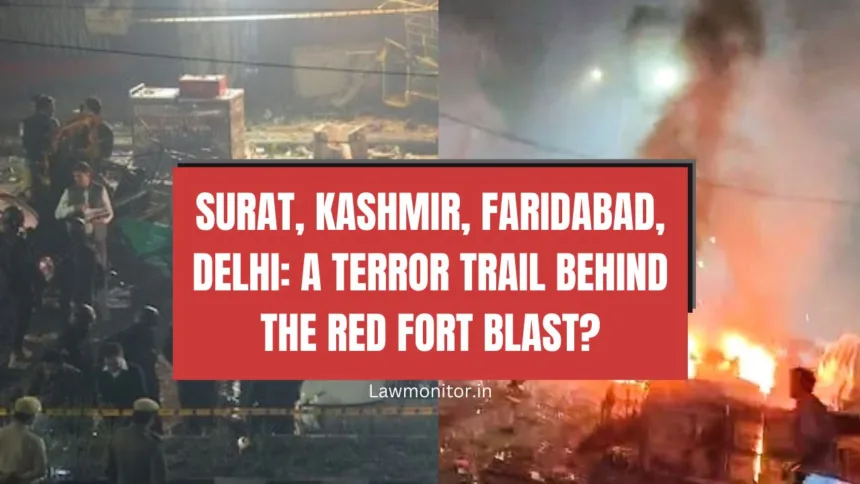New Delhi: A chilling network of alleged terror activity appears to have surfaced across multiple states — from Gujarat to Jammu and Kashmir — culminating in Monday evening’s deadly explosion near Delhi’s iconic Red Fort.
A series of seemingly unrelated arrests preceded the blast, now raising questions about possible coordination among different suspects and locations.
On Sunday night, police apprehended a Gujarat-based doctor carrying three handguns and materials capable of producing ricin, a dangerous bioweapon. Around the same time, in Haryana’s Faridabad, authorities detained another man from Jammu and Kashmir with 2,900 kilograms of explosive material, including 350 kilograms of ammonium nitrate and two assault rifles. Meanwhile, a third suspect, also from J&K, was arrested in Uttar Pradesh for putting up posters hailing Jaish-e-Mohammed, the Pakistan-based militant organization.
Barely 24 hours later, Delhi was rocked by a high-intensity explosion near the Red Fort. A Hyundai i20 car bearing Haryana registration number HR26 CE 7674 detonated at the Subhash Marg traffic signal outside Gate 1 of the Lal Qila metro station. The blast killed nine people and injured twenty. Twenty-two nearby vehicles caught fire, with the blast’s force shredding metal and scattering debris across the busy junction.
The Doctor, the Module, and the Blast
Investigators are now probing whether these arrests and the Red Fort attack share a common thread. Sources suggest a disturbing connection between the explosion and a so-called “white-collar” terror module spanning multiple states.
The car used in the blast was reportedly registered to Dr Umar Mohammad from Pulwama, south Kashmir. According to intelligence officials, Mohammad was part of the same module dismantled earlier that day. After learning that two of his close aides — Dr Mujammil Shakeel and Dr Adil Rather — had been captured along with a massive cache of explosives in Faridabad, Mohammad allegedly panicked.
In what officials believe was a last-ditch act of desperation, Umar drove the car filled with explosives to the Red Fort area and triggered the deadly blast himself. He had reportedly planted a detonator and planned the attack alongside two other operatives.
A Wider Network
The discovery of nearly three tons of explosives barely 50 kilometers from Delhi underscores the scale of the threat. Investigators are now exploring possible links between the Gujarat bioweapon case and the Faridabad seizure, suggesting the existence of a larger, coordinated terror infrastructure.
Preliminary intelligence points to a sophisticated network of operatives blending professional profiles with extremist intent — a pattern that security agencies have dubbed “white-collar terrorism.”
While forensic teams comb the Red Fort site for traces of explosive material, high-level meetings are underway between central and state security agencies. The National Investigation Agency (NIA) is expected to take over the probe, tracing the origins of funding, ideology, and cross-border connections behind the module.
The Red Fort blast has reignited concerns about urban terror cells and the vulnerabilities of public spaces in the heart of the capital, once again placing the spotlight on the complex and evolving nature of domestic terror threats in India.



